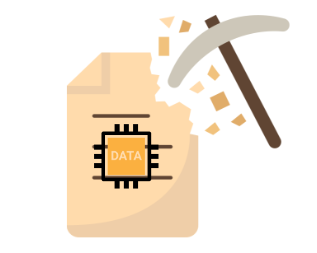The Data Mining process comprises analysing and interpreting information from large data sets by finding patterns and creating models. With the help of data mining, it is possible to extract valuable information from large amounts of raw data.
In this article, we will learn more about the data mining process and its importance.
What is the Data Mining Process?
The Data Mining process is a process of analysing and interpreting large amounts of data to find valuable information. We aim to find the patterns inside the data, something that makes connections, and then information is extracted.

The data mining process follows a series of steps such as business objectives, data understanding, data preparation, modeling, evaluation, and deployment.
Data Mining Process Key Takeaways
- Data Mining Process is a method of extracting valuable information after analysing and interpreting a large dataset.
- The method adopted in data mining is finding patterns and co-relations between the data elements.
- Data mining can be used in fraud detection, credit risk management, spam filtering, and learning what customers are more interested in based on current trends.
Also, check What is Data Science LifeCycle?
Working on the Data Mining Process
Data Mining is a process of converting raw data into useful information. However, it is more focused on finding meaningful patterns and trends.

First, data is collected from a large warehouse involving numerous sources. This collected data is loaded on a site. Now, other teams like data analysts, data scientists, management teams, and business analysts, etc have to access the data and organise the data in a meaningful manner. They basically determine the way they want to organize the data.
The information collected from the data source is then shared with the end-user in a friendly interface format such as charts, tables or graphs.
Data Mining Process
The data mining process goes through a series of steps generally implemented by data analysts. It is important to follow these steps to extract valuable information from data.
1. Understand the business objective
You must be familiar with the business goals before extracting data information. Get to know the company goal behind trying to implement data mining. Implement a quick SWOT analysis and prepare a thorough report, marking every important factor.
2. Understand the data
To start with data mining, it is very important to be aware of the type of data, structure, quality, and context. Explore the data and collect valuable information to get a better understanding of different parameters of data.
This step marks an important place in identifying patterns and relationships in data. At the end, the concerned team must mark if the data is suitable for analysis purposes or not.
Also, check, What is meant by Data Processing and its uses?
3. Data Preparation

This step is acknowledged as the data is prepared and available for analysis purposes. Before putting the data for analysis, it is first cleaned, errors are removed, and inconsistencies are removed to make it suitable for analysis. This step is crucial as it ensures that the given data is present in a format suitable for loading.
4. Modeling
A predictive model is prepared using machine learning algorithms. An appropriate algorithm is selected based on the objective of the model. Now, the data is trained and performance is evaluated. These predictive models help to search for current trends, patterns, relationships and associations in the data.
Also, Check Supervised Machine Learning in Data Science
5. Output evaluation
The model performance must be evaluated to assess how sufficient the model is to predict outcomes from the new data. This step is very important as it helps to calculate how accurate the predictions of the model are as it is an important criterion before the model is started being used in the real time environment.
6. Deployment

After a thorough analysis of the model, it is deployed in a controlled environment. The model is integrated into the system and output is calculated in real-time. This step evaluates whether the model is capable of generating value for the organisation.
Pros of Data Mining Process
There are many pros of data mining in various categories inside an organization. Some of the benefits of data mining are mentioned below.
- The data mining process helps to discover hidden or undiscovered insights and trends. It extracts valuable information by pattern matching and relationship extraction through machine learning algorithms and statistical analysis.
- It saves a lot of money as data is filtered and well structured before being trained. Hence, any obstacles during the operation are significantly lowered.
- Data from various sources can easily be analysed and discovered. Patterns are interpreted to find connections within data.
- It helps to increase the efficiency of the processes.
- Data mining has a wide range of applications in sales, marketing, fraud detection, manufacturing, and much more.
- It focuses on large datasets and databases.
Application of Data Mining Process
The data mining process is used across multiple fields and areas. Let us know a few of them.
-
- Financial data analysis: Data mining is widely used in banking, investment, loans, insurance and investment services. The data collected from various sources are interpreted and analysed to predict their quality.
- Fraud detection and prevention: The data mining process can help in the detection of any intrusion possibilities by analysing large datasets in real time. With machine learning algorithms, intrusion detection and prevention is more effective.
- Uncover trends: Large datasets can be analyzed to uncover hidden trends that can drive huge profits for businesses.
- Retail and communication industries: Sectors like sales, transportation, and consumption services rely on huge amounts of data. The data from retail and communication can be collected and analysed to improve customer service and customer satisfaction.
How Machine Learning Affects the Data Mining Process?
Machine Learning enhances the efficiency of the data mining process by automating complex tasks, and unique patterns, and improving decision-making processes within an organization. Machine learning models have greatly influenced the data mining process and made it effective.
Now, we can easily handle missing data in real time using the K-nearest neighbors algorithm or advanced techniques like matrix factorization. It also improved the data normalization and scaling methods used in data processing.
With the help of machine learning algorithms, complex patterns can be detected. Many machine learning algorithms, like random forests, neural networks, support vector machines, etc can be used for this purpose.
We can easily automate the feature selection process using machine learning models. Now, classification, anomaly detection, clustering, predictive modeling, forecasting, etc can be optimized for big data effectively.
Learn Data Science with PW Skills
Become a certified data scientist with PW Skills Data Science with Generative AI Course. Master Machine Learning, NLP, Python, Power BI, Generative AI, and more within this course. You will get to work on capstone projects under the guidance of our experienced mentors.
Strengthen your knowledge with practice exercises, module level assignments, instructor led sessions, and more. You can use pw skills free online compiler, pw lab for all your coding. Also, get interview opportunities after completing the course only at pwskills.com
Data Mining Process FAQs
Q1. What is the data mining process?
Ans: Data mining is a process of extracting useful information from large datasets extracted from data warehouses. It is very helpful for companies to make decisions and competitive analysis.
Q2. What are the seven steps in the data mining process?
Ans: The data mining process follows a series of steps to extract useful information from a large volume of data.
Data cleaning
Data integration
Data reduction
Data Transformation
Data mining
Pattern recognition
Evaluation
deployment
Q3. What are the five stages of the data mining process?
Ans: The five essential stages in the data mining process are listed below.
Data Collection
Data Preprocessing
Data Exploration
Data Modeling
Evaluation
Q4. What is the benefit of data mining?
Ans: There are many benefits of data mining as it helps to uncover hidden trends, increase operational efficiency, and help businesses make data-driven decisions.






